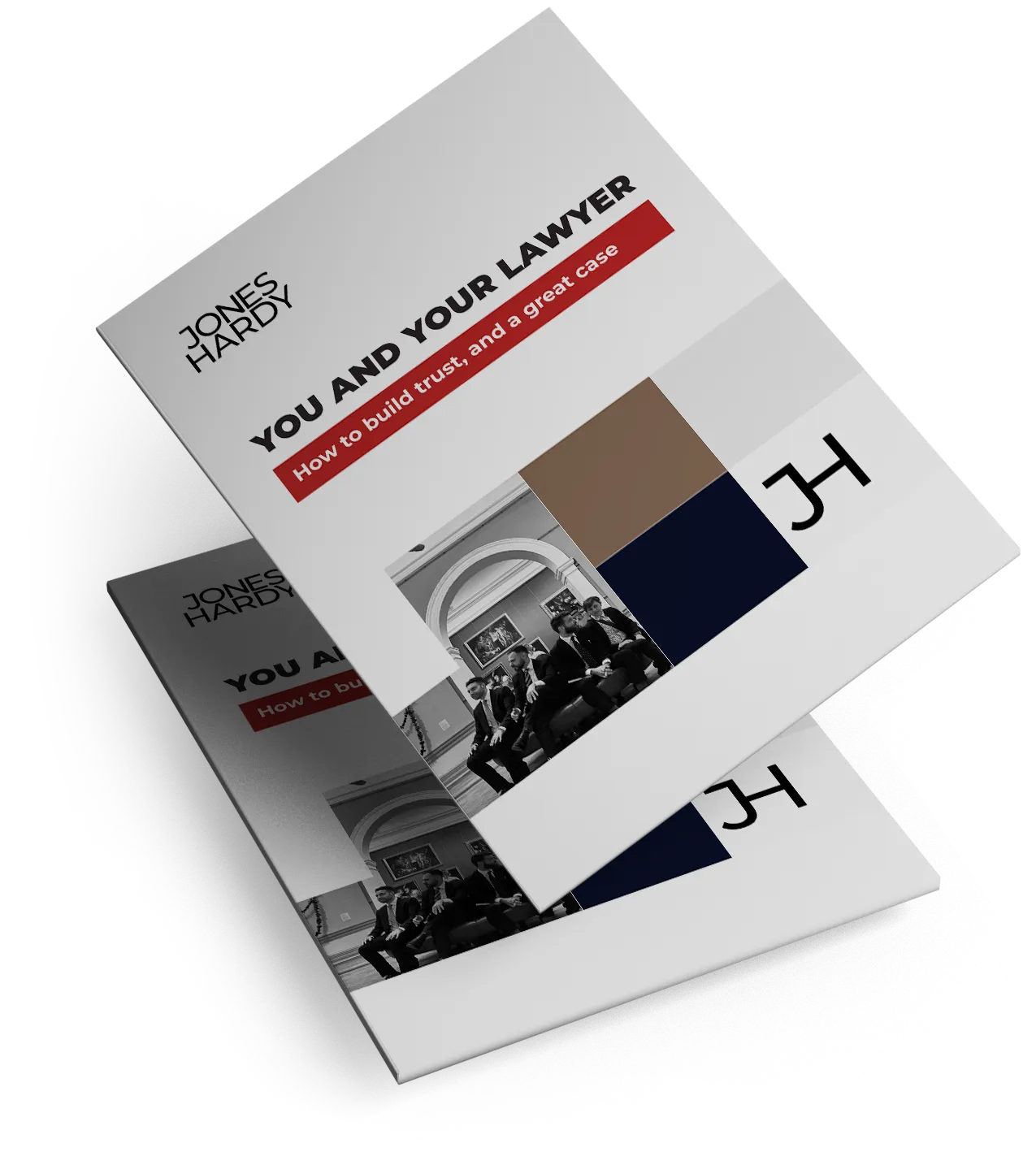
If you’re searching for a coercive control lawyer in NSW, a coercive control defence solicitor, or help because you’ve been charged with coercive control in NSW, this long-form guide explains the law. We cover what the offence is, when it started (1 July 2024), the key elements, defences, practical prosecution and defence strategies, and what to do next. We also include quick “Myth vs Fact” callouts and answers to common Google questions. We act for both complainants seeking protection and defendants who need a robust defence across New South Wales.
At Jones Hardy Law, we’ve advised and defended in complex domestic violence matters for years. Coercive control cases are different: they turn on a pattern of behaviour, not a single event. That makes the evidence strategy decisive from day one.
What is coercive control?
Coercive control is a course of conduct used to dominate, isolate or subjugate a current or former intimate partner. It is often non-physical: monitoring movements, restricting money or transport, isolating a partner from friends, threats or humiliation, and technological surveillance. NSW has now criminalised this pattern where particular legal elements are met under the Crimes Act 1900 (NSW). See the direct statutory extract in Section 3 below. NSW Legislation
Myth vs Fact
Myth: “You can’t be charged unless there’s physical violence.”
Fact: The offence targets patterns of abusive behaviour. No physical assault is required if the section 54D elements are proven.
Is coercive control now a crime in NSW? (and when did it start?)
Yes. The coercive control offence commenced on 1 July 2024. It applies to conduct on or after that date. Earlier conduct may still be relevant as context where a course of conduct continues past commencement, but the new offence does not itself criminalise completed pre-commencement behaviour. The NSW Judicial Commission Bench Book confirms the 1 July 2024 start date and notes the offence only applies to conduct occurring on or after commencement. judcom.nsw.gov.au
The legislation: the key elements
Section 54D of the Crimes Act 1900 (NSW) provides (extract):
“An adult commits an offence if—
(a) the adult engages in a course of conduct against another person that consists of abusive behaviour, and
(b) the adult and other person are or were intimate partners, and
(c) the adult intends the course of conduct to coerce or control the other person, and
(d) a reasonable person would consider the course of conduct would be likely, in all the circumstances, to cause any or all of the following, whether or not the fear or impact is in fact caused—
(i) fear that violence will be used against the other person or another person, or
(ii) a serious adverse impact on the capacity of the other person to engage in some or all of the person’s ordinary day-to-day activities.” AustLII
Two further provisions matter in practice:
- Defence – s 54E: “In proceedings for an offence under section 54D(1), it is a defence if the course of conduct was reasonable in all the circumstances.” AustLII Classic
- Procedural requirements – s 54H: prosecutors must allege “the nature and description of the behaviours that amount to the course of conduct, and … the particulars of the period of time over which the course of conduct took place.” corrigan.austlii.edu.auTaylor & Francis Online
Maximum penalty: 7 years’ imprisonment (on indictment). Proceedings are summary unless elected to be dealt with on indictment. NSW Legislation
What counts as “abusive behaviour”?
The Act captures behaviour that “consists of or involves” violence, threats or intimidation, and also coercion or control—for example: isolating a partner, monitoring communications, restricting access to money and transport, humiliating or degrading conduct, or creating an atmosphere of intimidation. It’s the pattern that matters, assessed through the reasonable person test. NSW Legislation
Myth vs Fact
Myth: “If messages are polite, it can’t be abuse.”
Fact: A pattern of surveillance or micro-restrictions can meet the test even without overt threats, if a reasonable person would consider the conduct likely to cause fear or a serious adverse impact on day-to-day activities. AustLII
Transitional issues (important)
Only conduct on or after 1 July 2024 can itself constitute the new offence. However, pre-commencement events may still be:
- charged under other offences (e.g., stalking/intimidation or ADVO breach), and/or
- relied on to explain the context where the course of conduct continues past commencement. judcom.nsw.gov.auAustLII
How police build a coercive control brief
Because the law targets a course of conduct, briefs typically combine:
- Digital material (texts, emails, social media, location logs).
- Financial and access records (bank statements, vehicle GPS, keycards).
- Third-party and expert evidence (friends, medical notes, DV specialists).
- Timing analysis to demonstrate repetition and escalation across a defined period.
Charging decisions may occur before all material is collected; particulars can be refined as evidence is obtained. Early defence engagement can influence the scope and particulars. (See s 54H procedural focus on nature of behaviours and time period.) corrigan.austlii.edu.au
Common defence strategies we consider
Every case turns on its facts, but we typically examine:
- Gaps and clustering: Do the alleged acts truly form a course of conduct, or are there long gaps/inconsistencies that undermine the “pattern”?
- Element (c) – intent to coerce or control: What do contemporaneous records show about motive and intent?
- Element (d) – the reasonable person test: Would the alleged pattern be likely to cause fear of violence or a serious adverse impact on day-to-day activities, viewed objectively?
- Consent/agency/context: Were some behaviours consensual, culturally contextualised, or bilateral? Are there lawful/explanatory reasons (e.g., safety planning, parenting orders)?
- Alternative inferences: Are there neutral explanations for monitoring (e.g., shared accounts, business admin, legitimate safety concerns)?
- Evidentiary reliability: We scrutinise editing, selection, and sequencing of messages; metadata; and any missing context.
- s 54E defence: Can the conduct be framed as reasonable in all the circumstances—for example, crisis-driven or protective steps? AustLII Classic
Myth vs Fact
Myth: “One or two unpleasant texts can amount to coercive control.”
Fact: The statute requires a course of conduct—a pattern. Not every unhealthy exchange crosses the criminal threshold. AustLII
Prosecutorial particulars and time-periods
Under s 54H, prosecutors must set out the behaviours and the timeframe of the alleged pattern. Particulars that are too broad can be challenged; particulars that are too narrow may fail to capture the alleged pattern. We frequently seek clarity here because the particulars drive both disclosure and trial strategy. corrigan.austlii.edu.auTaylor & Francis Online
How this differs from older NSW approaches
Before 1 July 2024, police and courts relied on:
- Stalking/intimidation under s 13 of the Crimes (Domestic and Personal Violence) Act 2007 (NSW).
- Apprehended Domestic Violence Orders (ADVOs) and breach offences (s 14).
- Tendency, relationship and context evidence to explain non-reporting or late reporting.
The new offence recognises the cumulative harm of non-physical abuse and allows earlier intervention when the elements are met. NSW Legislation
Quick comparisons with overseas cases (what NSW can learn)
England & Wales – s 76 Serious Crime Act 2015:
The Court of Appeal in R v Chilvers [2021] EWCA Crim 1311 addressed jury directions in controlling or coercive behaviour prosecutions, underscoring the need to assess the pattern and its impact across the charged period—not isolated incidents. Courts and Tribunals Judiciary
Scotland – Domestic Abuse (Scotland) Act 2018:
Scottish courts emphasise corroborating the overall pattern using multiple strands of evidence. Public data indicate substantial volumes of charges, signalling system-wide implementation (police, prosecutors, courts). STV News
Take-away for NSW: Courts overseas treat chronology, particularisation, and corroboration of the pattern as pivotal. NSW prosecutors and judges are likely to do the same.
FAQs
Q: What is an example of coercive control?
A: Repeated monitoring of a partner’s movements, pressuring them to cut ties with friends, and restricting access to money and transport—especially when combined and sustained—can indicate a course of conduct meeting s 54D (depending on intent and the reasonable person test). NSW Legislation
Q: Can you be charged without physical violence?
A: Yes. No physical assault is required if the s 54D elements are satisfied: a course of conduct of abusive behaviour towards an intimate partner, intended to coerce or control, and that a reasonable person would consider likely to cause fear of violence or a serious adverse impact on day-to-day activities. AustLII
Q: Is it a defence that I was trying to keep my partner safe?
A: It depends. s 54E creates a defence where the course of conduct was reasonable in all the circumstances—but the prosecution can rebut it. Get advice immediately. AustLII Classic
Q: What is the maximum penalty?
A: Up to 7 years’ imprisonment (on indictment), with the matter ordinarily dealt with summarily unless elected. NSW Legislation
Q: When did the offence start?
A: 1 July 2024. The offence only applies to conduct on or after that date. judcom.nsw.gov.au
If you need protection (complainants)
- Document the pattern (messages, call logs, bank records, journals).
- Speak to police and obtain an ADVO where appropriate.
- Safety first: create a plan; engage support services.
- Get early legal advice: we can help with strategy, evidence and court applications.
Internal link prompt: link ADVO breach to your ADVO services page.
If you’re accused (defendants)
- Do not contact the complainant (this risks new charges or ADVO breach).
- Preserve evidence (full message threads, device backups, calendars, third-party records).
- Write down a chronology while memories are fresh.
- Get experienced representation quickly—particulars and disclosure strategy are time-critical.
Internal link prompts: link domestic violence lawyer in NSW to your domestic violence practice page; link criminal defence solicitor to your main defence page.
If you’re dealing with a coercive control situation—seeking protection or defending an allegation—contact Jones Hardy Law for confidential advice: [email protected]. We act across NSW and can assist urgently.
Our approach at Jones Hardy Law
We front-load work on particulars, chronology, and disclosure. We test each element of s 54D, press for proper s 54H particulars, and assess any s 54E defence. Where appropriate, we integrate insights from social science, technology forensics, and family-law interface issues (parenting orders, property, cross-allegations). We also pay close attention to transitional issues and whether alleged conduct spans pre- and post-1 July 2024. judcom.nsw.gov.au
Final word (and how we can help)
Coercive control prosecutions are complex because they focus on patterns, intent, and the reasonable person test. The earlier you get advice, the better your position—whether you’re seeking protection or facing an allegation.
Email [email protected]. We represent clients across New South Wales.
About the author
Written by Nicholas Hardy-Clements, Director at Jones Hardy Law, Specialist Criminal Defence Solicitor (NSW) with over a decade of experience.
Sources for dates, offence elements and procedural points
- NSW Crimes Act 1900, ss 54D, 54E, 54H (current, NSW legislation site/AustLII). NSW LegislationAustLIIAustLII Classiccorrigan.austlii.edu.au
- NSW Judicial Commission Bench Book — start date 1 July 2024 and application to post-commencement conduct only. judcom.nsw.gov.au
- Bill/Explanatory materials confirming maximum penalty 7 years and summary/indictable pathway. NSW Legislation
- Overseas context and cases (England & Wales; Scotland). Courts and Tribunals JudiciarySTV News

Domestic Violence Sentencing Principles in NSW
Domestic violence remains one of the most serious criminal law issues facing the NSW justice system. The courts have recognised — in The Queen v Kilic (2016) 259 CLR 256 at [21] — that there has been a clear societal shift. Past sentencing practices no longer reflect the community’s growing concern about violence, often committed by men against women, in a domestic context.
The law now places strong emphasis on general deterrence, specific deterrence, and community protection. As Wilson J stated in Yaman v R [2020] NSWCCA 239 at [135] (Fullerton and Ierace JJ agreeing):
“The right of all women to determine their own path in life must be protected and upheld by the courts. Where a woman’s right is ignored or disregarded by an offender, that right must be vindicated, including by punitive and strongly deterrent sentences where necessary.”
Statutory Framework
Under the Crimes (Domestic and Personal Violence) Act 2007 (NSW):
- Section 11 defines a domestic violence offence as a personal violence offence (s 4), or related conduct, committed against someone with whom the offender has, or had, a domestic relationship (s 5).
- Section 6A, introduced by the Crimes Legislation Amendment (Coercive Control) Act 2022, defines domestic abuse to include behaviours causing fear, intimidation, or harm.
- Section 4A Crimes (Sentencing Procedure) Act 1999 generally requires either full-time imprisonment or a supervised order (ICO, CCO, CRO) for a domestic violence offence, unless another sentence is more appropriate and reasons are given.
- Section 4B adds victim-safety requirements when imposing community-based orders.
- Sections 39–40 Crimes (Domestic and Personal Violence) Act 2007 require the court to make a final Apprehended Domestic Violence Order (ADVO) following conviction for a serious domestic violence offence unless an order is not required.
Domestic violence orders are nationally recognised and enforceable across Australia.
Judicial Approach to Sentencing
Courts treat domestic violence as a seriously aggravating factor. In Munda v Western Australia (2013) 249 CLR 600 at [54]–[55], the High Court emphasised that sentencing must vindicate the dignity of the victim, denounce the offending, and protect the vulnerable.
Similarly, in Cherry v R [2017] NSWCCA 150 at [78], Johnson J said:
“The criminal law, in the area of domestic violence, requires rigorous and demanding consequences for perpetrators for the purpose of protecting partners, family members and the wider community.”
The importance of deterrence and denunciation has also been stressed in Ngatamariki v R [2016] NSWCCA 155 at [73], R v JD [2018] NSWCCA 233, R v Hamid (2006) 164 A Crim R 179 at [86], and Turnbull v R [2019] NSWCCA 97 at [153].
Courts have made it clear that victim forgiveness (Simpson v R [2014] NSWCCA 23; R v Eckermann [2013] NSWCCA 188; Ahmu v R [2014] NSWCCA 312) or an offender’s personal background (Kennedy v R [2022] NSWCCA 215) does not diminish the seriousness of the offence or the need for stern sentencing.
Special Considerations
- Victims may be vulnerable due to emotional attachment, physical disparity, or coercive control (R v Burton [2008] NSWCCA 128 at [97]; Patsan v R [2018] NSWCCA 129 at [39]–[40]).
- Delay in reporting is common and cannot be used to discredit a victim (Hurst v R [2017] NSWCCA 114 at [132]).
- An offender’s belief that they have been wronged never justifies violence (Xue v R [2017] NSWCCA 137 at [53]; Efthimiadis v R (No 2) [2016] NSWCCA 9 at [86]).
- Courts must be cautious in applying the aggravating factor of vulnerability without proper evidentiary basis (Drew v R [2016] 264 CLR 310).

